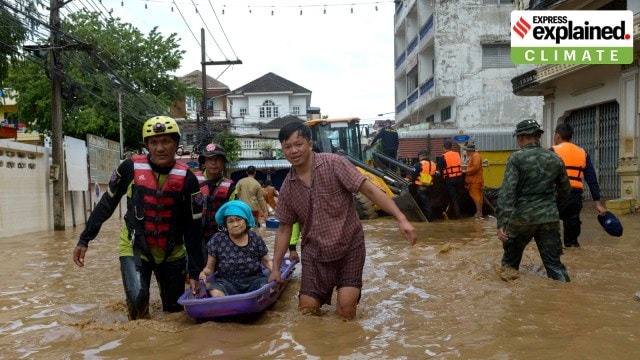Behind Typhoon Yagi becoming the most powerful storm in Asia this year
While Typhoon Yagi has severely impacted multiple countries, including the Philippines, China, Laos, Myanmar, and Thailand, it has hit Vietnam the hardest, where the death toll stands at around 233
 Rescue workers help a stranded woman from a flooded area at the border town of Mae Sai, following the impact of Typhoon Yagi, in the northern province of Chiang Rai, Thailand, September 12, 2024. (Photo: Reuters)
Rescue workers help a stranded woman from a flooded area at the border town of Mae Sai, following the impact of Typhoon Yagi, in the northern province of Chiang Rai, Thailand, September 12, 2024. (Photo: Reuters)Millions of people in Southeast Asia continue to struggle with torrential rains, floods, and landslides triggered by Typhoon Yagi — the strongest tropical cyclone Asia has seen this year and the second most powerful storm in the world so far this year after Hurricane Beryl.
While Typhoon Yagi has severely impacted multiple countries, including the Philippines, China, Laos, Myanmar, and Thailand, it has hit Vietnam the hardest, where the death toll stands at around 233. The overall toll across these countries has crossed 300 as of last week. As many people are still missing, it is expected to rise further.
How are tropical cyclones formed?
 Tropical cyclones form over warm ocean waters near the equator. When the warm, moist air from the ocean surface rises upward, a lower air pressure area is formed below. Air from surrounding areas with higher air pressure rushes into this low pressure area, eventually rising, after it also becomes warm and moist.
Tropical cyclones form over warm ocean waters near the equator. When the warm, moist air from the ocean surface rises upward, a lower air pressure area is formed below. Air from surrounding areas with higher air pressure rushes into this low pressure area, eventually rising, after it also becomes warm and moist.
As warm, moist air rises, it cools down, and the water in the air forms clouds and thunderstorms. This whole system of clouds and winds gains strength and momentum using the ocean’s heat, and the water that evaporates from its surface.
“The weakest tropical cyclones are called tropical depressions. If a depression intensifies such that its maximum sustained winds reach 39 miles per hour [63 kmph], the tropical cyclone becomes a tropical storm,” according to the National Oceanic and Atmospheric Administration (NOAA). Storm systems with wind speeds of 119 kmph and above are classified as hurricanes, typhoons, or tropical cyclones.
The category of a tropical cyclone is determined by its sustained wind speed, as measured by the Saffir-Simpson Hurricane Wind Scale. It is classified into five categories — Category 1 to Category 5. While Category 1 tropical cyclones bring winds of 119 to 153 kmph, Category 5 tropical cyclones, which are the strongest, have winds of 252 kmph or higher. Storms that reach Category 3 and higher are considered major tropical cyclones due to their potential to inflict significant damage.
How did Typhoon Yagi become the strongest storm in Asia?
Typhoon Yagi started as a tropical storm in the western Philippine Sea on September 1. It made landfall in the Philippines the next day and started to weaken. However, due to unusually warm waters in the South China Sea, the storm intensified again. By September 4, it strengthened into a strong typhoon with Category 3 winds.
The next day, it became a Category 5 typhoon with peak maximum sustained winds of 260 kmph — Typhoon Yagi is one of four Category 5 storms recorded in the South China Sea, after Pamela in 1954, Rammasun in 2014, and Rai in 2021.
On September 6, it made a landfall in China’s Hainan province with winds of 223 kmph. The following day, Typhoon Yagi hit near Haiphong, Quang Ninh province, in northern Vietnam, as one of the strongest storms the country has seen in more than a decade.
The storm was subsequently downgraded to a tropical depression but still brought heavy rains last week in countries such as Myanmar, where it triggered severe floods around the remote capital, Naypyidaw.
Is climate change making tropical cyclones worse?
Scientists are yet to reach an agreement over how exactly climate change is impacting tropical cyclones. That is because there are a lot of factors that determine whether a storm forms, how it develops, its strength, duration and overall characteristics.
However, there is a consensus that with rising global temperatures, tropical cyclones are becoming more intense. For instance, a study published in the journal Climate and Atmospheric Science in July this year showed that tropical cyclones in Southeast Asia are now forming closer to coastlines, intensifying more rapidly, and lingering longer over land.
This could be happening primarily because of warmer surface temperatures of the ocean — global mean sea surface temperature has gone up by close to 0.9 degree Celsius since 1850 and around 0.6 degree Celsius over the last four decades.
Higher sea surface temperatures cause marine heat waves, an extreme weather event, which can also make storms like hurricanes and tropical cyclones more intense. Warmer temperatures escalate the rate of evaporation along with the transfer of heat from the oceans to the air. When storms travel across hot oceans, they gather more water vapour and heat. This results in stronger winds, heavier rainfall and more flooding when storms reach the land.





- 01
- 02
- 03
- 04
- 05

































